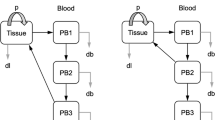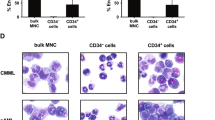Abstract
The clinical course of patients with recently diagnosed early stage chronic lymphocytic leukemia (CLL) is highly variable. We examined the relationship between CLL-cell birth rate and treatment-free survival (TFS) in 97 patients with recently diagnosed, Rai stage 0–II CLL in a blinded, prospective study, using in vivo 2H2O labeling. Birth rates ranged from 0.07 to 1.31% new cells per day. With median follow-up of 4.0 years, 33 subjects (34%) required treatment by NCI criteria. High-birth rate was observed in 44% of subjects and was significantly associated with shorter TFS, unmutated IGHV status and expression of ZAP70 and of CD38. In multivariable modeling considering age, gender, Rai stage, expression of ZAP70 or CD38, IGHV mutation status and FISH cytogenetics, only CLL-cell birth rate and IGHV mutation status met criteria for inclusion. Hazard ratios were 3.51 (P=0.002) for high-birth rate and 4.93 (P<0.001) for unmutated IGHV. The association between elevated birth rate and shorter TFS was observed in subjects with either mutated or unmutated IGHVs, and the use of both markers was a better predictor of TFS than either parameter alone. Thus, an increased CLL birth rate in early stage disease is a strong predictor of disease progression and earlier treatment.
This is a preview of subscription content, access via your institution
Access options
Subscribe to this journal
Receive 12 print issues and online access
$259.00 per year
only $21.58 per issue
Buy this article
- Purchase on Springer Link
- Instant access to full article PDF
Prices may be subject to local taxes which are calculated during checkout





Similar content being viewed by others
References
Chiorazzi N, Rai KR, Ferrarini M . Chronic lymphocytic leukemia. N Engl J Med 2005; 352: 804–815.
Zhang S, Kipps TJ . The pathogenesis of chronic lymphocytic leukemia. Annu Rev Pathol 2014; 9: 103–118.
Rai KR, Sawitsky A, Cronkite EP, Chanana AD, Levy RN, Pasternack BS . Clinical staging of chronic lymphocytic leukemia. Blood 1975; 46: 219–234.
Binet JL, Auquier A, Dighiero G, Chastang C, Piguet H, Goasguen J et al. A new prognostic classification of chronic lymphocytic leukemia derived from a multivariate survival analysis. Cancer 1981; 48: 198–206.
Binet JL, Caligaris-Cappio F, Catovsky D, Cheson B, Davis T, Dighiero G et al. Perspectives on the use of new diagnostic tools in the treatment of chronic lymphocytic leukemia. Blood 2006; 107: 859–861.
Delgado J, Baumann T, Santacruz R, Montserrat E . New treatment options for chronic lymphocytic leukemia. Expert Opin Pharmacother 2014; 15: 823–832.
Hallek M . Chronic lymphocytic leukemia: 2015 Update on diagnosis, risk stratification, and treatment. Am J Hematol 2015; 90: 446–460.
Rassenti LZ, Huynh L, Toy TL, Chen L, Keating MJ, Gribben JG et al. ZAP-70 compared with immunoglobulin heavy-chain gene mutation status as a predictor of disease progression in chronic lymphocytic leukemia. N Engl J Med 2004; 351: 893–901.
Damle RN, Wasil T, Fais F, Ghiotto F, Valetto A, Allen SL et al. Ig V gene mutation status and CD38 expression as novel prognostic indicators in chronic lymphocytic leukemia. Blood 1999; 94: 1840–1847.
Bulian P, Shanafelt TD, Fegan C, Zucchetto A, Cro L, Nuckel H et al. CD49d is the strongest flow cytometry-based predictor of overall survival in chronic lymphocytic leukemia. J Clin Oncol 2014; 32: 897–904.
Dohner H, Stilgenbauer S, Benner A, Leupolt E, Krober A, Bullinger L et al. Genomic aberrations and survival in chronic lymphocytic leukemia. N Engl J Med 2000; 343: 1910–1916.
Hamblin TJ, Davis Z, Gardiner A, Oscier DG, Stevenson FK . Unmutated Ig V(H) genes are associated with a more aggressive form of chronic lymphocytic leukemia. Blood 1999; 94: 1848–1854.
Messmer BT, Messmer D, Allen SL, Kolitz JE, Kudalkar P, Cesar D et al. In vivo measurements document the dynamic cellular kinetics of chronic lymphocytic leukemia B cells. J Clin Invest 2005; 115: 755–764.
Defoiche J, Debacq C, Asquith B, Zhang Y, Burny A, Bron D et al. Reduction of B cell turnover in chronic lymphocytic leukaemia. Br J Haematol 2008; 143: 240–247.
van Gent R, Kater AP, Otto SA, Jaspers A, Borghans JA, Vrisekoop N et al. In vivo dynamics of stable chronic lymphocytic leukemia inversely correlate with somatic hypermutation levels and suggest no major leukemic turnover in bone marrow. Cancer Res 2008; 68: 10137–10144.
Dameshek W . Chronic lymphocytic leukemia–an accumulative disease of immunolgically incompetent lymphocytes. Blood 1967; 29 (Suppl): 566–584.
Hallek M, Cheson BD, Catovsky D, Caligaris-Cappio F, Dighiero G, Dohner H et al. Guidelines for the diagnosis and treatment of chronic lymphocytic leukemia: a report from the International Workshop on Chronic Lymphocytic Leukemia updating the National Cancer Institute-Working Group 1996 guidelines. Blood 2008; 111: 5446–5456.
Rassenti LZ, Jain S, Keating MJ, Wierda WG, Grever MR, Byrd JC et al. Relative value of ZAP-70, CD38, and immunoglobulin mutation status in predicting aggressive disease in chronic lymphocytic leukemia. Blood 2008; 112: 1923–1930.
Hayes GM, Busch R, Voogt J, Siah IM, Gee TA, Hellerstein MK et al. Isolation of malignant B cells from patients with chronic lymphocytic leukemia (CLL) for analysis of cell proliferation: validation of a simplified method suitable for multi-center clinical studies. Leuk Res 2010; 34: 809–815.
Chen JL, Peacock E, Samady W, Turner SM, Neese RA, Hellerstein MK et al. Physiologic and pharmacologic factors influencing glyceroneogenic contribution to triacylglyceride glycerol measured by mass isotopomer distribution analysis. J Biol Chem 2005; 280: 25396–25402.
Voogt JN, Awada M, Murphy EJ, Hayes GM, Busch R, Hellerstein MK . Measurement of very low rates of cell proliferation by heavy water labeling of DNA and gas chromatography/pyrolysis/isotope ratio-mass spectrometric analysis. Nat Protoc 2007; 2: 3058–3062.
Asquith B, Debacq C, Macallan DC, Willems L, Bangham CR . Lymphocyte kinetics: the interpretation of labelling data. Trends Immunol 2002; 23: 596–601.
Ganusov VV, Borghans JA, De Boer RJ . Explicit kinetic heterogeneity: mathematical models for interpretation of deuterium labeling of heterogeneous cell populations. PLoS Comput Biol 2010; 6: e1000666.
Zimmerman TS, Godwin HA, Perry S . Studies of leukocyte kinetics in chronic lymphocytic leukemia. Blood 1968; 31: 277–291.
Calissano C, Damle RN, Hayes G, Murphy EJ, Hellerstein MK, Moreno C et al. In vivo intraclonal and interclonal kinetic heterogeneity in B-cell chronic lymphocytic leukemia. Blood 2009; 114: 4832–4842.
Herishanu Y, Perez-Galan P, Liu D, Biancotto A, Pittaluga S, Vire B et al. The lymph node microenvironment promotes B-cell receptor signaling, NF-kappaB activation, and tumor proliferation in chronic lymphocytic leukemia. Blood 2011; 117: 563–574.
Landau DA, Carter SL, Getz G, Wu CJ . Clonal evolution in hematological malignancies and therapeutic implications. Leukemia 2014; 28: 34–43.
Chiorazzi N . Implications of new prognostic markers in chronic lymphocytic leukemia. Hematol Am Soc Hematol Educ Program 2012; 2012: 76–87.
Fais F, Ghiotto F, Hashimoto S, Sellars B, Valetto A, Allen SL et al. Chronic lymphocytic leukemia B cells express restricted sets of mutated and unmutated antigen receptors. J Clin Invest 1998; 102: 1515–1525.
Rossi D, Terzi-di-Bergamo L, De Paoli L, Cerri M, Ghilardi G, Chiarenza A et al. Molecular prediction of durable remission after first-line fludarabine-cyclophosphamide-rituximab in chronic lymphocytic leukemia. Blood 2015; 126: 1921–1924.
Fischer K, Bahlo J, Fink AM, Goede V, Herling CD, Cramer P et al. Long-term remissions after FCR chemoimmunotherapy in previously untreated patients with CLL: updated results of the CLL8 trial. Blood 2016; 127: 208–215.
Thompson PA, Tam CS, O'Brien SM, Wierda WG, Stingo F, Plunkett W et al. Fludarabine, cyclophosphamide, and rituximab treatment achieves long-term disease-free survival in IGHV-mutated chronic lymphocytic leukemia. Blood 2016; 127: 303–309.
Defoiche J, Zhang Y, Lagneaux L, Pettengell R, Hegedus A, Willems L et al. Measurement of ribosomal RNA turnover in vivo by use of deuterium-labeled glucose. Clin Chem 2009; 55: 1824–1833.
Acknowledgements
We would like to thank the study participants, referring physicians and study coordinators at all six clinical sites where patients were recruited. We also acknowledge Robert Bush for important guidance in the development of protocols for CLL cell isolation necessary for this work, Dan Holquist for cell processing, and Mohammed Awada and Tim Riff for IRMS analyses. This work was supported in whole by federal funding from the National Cancer Institute, NIH, R44 CA100506 (E Murphy and G Hayes, PI) and PO1 CA081534 for the CLL Research Consortium (T Kipps, PI).
Author information
Authors and Affiliations
Corresponding author
Ethics declarations
Competing interests
This work was a collaboration between KineMed Inc. and the CRC and was funded entirely by NIH grants to both institutions. MH is on the board of directors at KineMed, Inc. MH is on the Board of Directors of KineMed Inc. No other authors have a current financial conflict of interest.
Additional information
Supplementary Information accompanies this paper on the Leukemia website
Supplementary information
Rights and permissions
About this article
Cite this article
Murphy, E., Neuberg, D., Rassenti, L. et al. Leukemia-cell proliferation and disease progression in patients with early stage chronic lymphocytic leukemia. Leukemia 31, 1348–1354 (2017). https://doi.org/10.1038/leu.2017.34
Received:
Revised:
Accepted:
Published:
Issue Date:
DOI: https://doi.org/10.1038/leu.2017.34
This article is cited by
-
Musashi 2 influences chronic lymphocytic leukemia cell survival and growth making it a potential therapeutic target
Leukemia (2021)
-
Next-generation CAR T cells to overcome current drawbacks
International Journal of Hematology (2021)
-
Sparse multiple co-Inertia analysis with application to integrative analysis of multi -Omics data
BMC Bioinformatics (2020)
-
The reference epigenome and regulatory chromatin landscape of chronic lymphocytic leukemia
Nature Medicine (2018)



